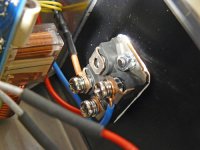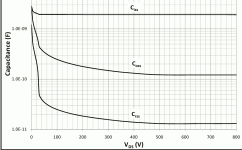Hi ! 
I'm new on this forum
I want to now if IXYS linear 2 mosfet series are good rated for audio amplification since they are designed for "linear amplifier".
IXYS Product Portfolio | Power Devices
How could we now if a lateral structure mosfet is good ?
what are the main criteria ?
Is the 2sk1058 the best ? mosfet are evolving all months, but only in switching applications (trench fet gen 2 - hexfet - GaN ...)
I'll eventually build a class a single ended preamp this month
thanks.
I'm new on this forum
I want to now if IXYS linear 2 mosfet series are good rated for audio amplification since they are designed for "linear amplifier".
IXYS Product Portfolio | Power Devices
How could we now if a lateral structure mosfet is good ?
what are the main criteria ?
Is the 2sk1058 the best ? mosfet are evolving all months, but only in switching applications (trench fet gen 2 - hexfet - GaN ...)

I'll eventually build a class a single ended preamp this month
thanks.
Those FETs might make great output stages (very high power handling and excellent low thermal resistance) but would not be a great choice for preamp duty - capacitances look very high. No P-channel parts listed either.
As to whether 2SK1058 is best, it depends what your evaluation criteria are - ruggedness (for example) or value for money? Its switching that has the volumes these days, which explains why the 2SK has been around unchanged for decades.
<edit> ooops, forgot to say - welcome to diya!
As to whether 2SK1058 is best, it depends what your evaluation criteria are - ruggedness (for example) or value for money? Its switching that has the volumes these days, which explains why the 2SK has been around unchanged for decades.
<edit> ooops, forgot to say - welcome to diya!
Last edited:
oops I wanted to say amp and not preamp, and in single ended class A there is no need for P channel.
so as I understand, since there is no evolution in lateral structure mosfet, the 2sk remains a good choice ?
maybe i could build an experimental amp with 2sk1058 and try another mosfet later
so i should search linear mosfet with low capacitance ?
thanks for your quick response.
so as I understand, since there is no evolution in lateral structure mosfet, the 2sk remains a good choice ?
maybe i could build an experimental amp with 2sk1058 and try another mosfet later
so i should search linear mosfet with low capacitance ?
thanks for your quick response.
so as I understand, since there is no evolution in lateral structure mosfet, the 2sk remains a good choice ?
A good choice amongst laterals yes. But then you're really looking at such a narrow range of available parts that its almost Hobson's. You've decided that laterals suit your application best? In a class A application where the quiescents are huge (relatively) I think the relative disadvantages of verticals are much reduced. Temperature stability for one hardly matters as the amp actually gets cooler when playing
so i should search linear mosfet with low capacitance ?
Lower capacitance is easier to drive, all other things being equal. MOSFETs usually have 3 capacitances specified on the datasheet, which ones are important depends on whether you're using it common-drain or common-source.
woody said:You might also want to look at the power jfets from Simisouth they have a lot less distortion but are expensive.
Well if we're really in price-no-object territory, how about this Cree one?
CREE | SiC MOSFET
I known SOT-227 MOSFET
Used in Gamut D200I SOT-227 case manufactued from Microsemi but I think it's look like IXYS, too
http://www.diyaudio.com/forums/soli...pull-pull-like-gamnut-whats-right-name-5.html
Thanks
Anadigit
Used in Gamut D200I SOT-227 case manufactued from Microsemi but I think it's look like IXYS, too
http://www.diyaudio.com/forums/soli...pull-pull-like-gamnut-whats-right-name-5.html
Thanks
Anadigit
Attachments
You've decided that laterals suit your application best? In a class A application where the quiescents are huge (relatively) I think the relative disadvantages of verticals are much reduced.
may vertical structure mosfet be a good choice for a single ended class A amp ?
Temperature stability for one hardly matters as the amp actually gets cooler when playing
hmm it is easier to find a very good mosfet with better thermal stability than a lateral structure.
Well if we're really in price-no-object territory, how about this Cree one?
CREE | SiC MOSFET
according what you says GaN mosfet may be better (or actually trenchfet Gen 3) : (page 3)
http://www.irf.com/product-info/ganpowir/GaNGeneral.pdf
@ ANADIGIT : seems the SOT 227 good for thermal stability
very interesting and nice forum
but 4:00 am for me (france), i'll go to sleep
ps : what about mosfet package parasite inductance ?
Last edited:
may vertical structure mosfet be a good choice for a single ended class A amp ?
Yeah, I tend to think so. Better because its cheaper and there are more sources out there. I would guess that Nelson Pass thinks so too. Why not go ask him as he's the man with the most experience in this department?
according what you says GaN mosfet may be better (or actually trenchfet Gen 3) : (page 3)
GaN FETs are new to me. Just from a quick read it seems their FOM (figure of merit) is based on Rds(ON) which is of zero consequence in linear applications. So for now, I recommend sticking with the traditional silicon based FETs for audio. If I was investing, I'd go with IR's Si-substrate approach rather than Cree's as it looks more cost effective.
ps : what about mosfet package parasite inductance ?
Not really an issue at audio frequencies with a linear amp. Big concern for switching amps though.
I would tend to think that FETs with the large die areas would be decent for class A or AB amplifiers these days because the junction to case thermal resistance is so low. A 1/2 degree C per Watt is common place these days for even TO-220 packages. The lower that figure, the larger the die area and the easier it is go get heat out of the silicon.
Yeah, you might have to design a decent driver circuit of course. That should be the fun part !
boB
Yeah, you might have to design a decent driver circuit of course. That should be the fun part !
boB
Like those SemiSouth SiC JFETs, this looks like another device that's going to have to run at higher than usual voltages (attached). You could run 'em as source followers operating into an OPT at 600Vdc.
The SiC JFETs looked to be very linear. Not too sure these are so much better than Si MOSFETs operating at more convenient voltages.
Attachments
Old thread but still very pertinent...
How does one go about choosing the best output device?
I do subscribe to the argument that the workings of the brain are not well understood and there is not a good translation of what `sounds good' into something that is readily measured quantitatively. On the other hand there is an element of physics here, so we should at least be able to agree on the type of things that are important and how some parameters may be important:
Maximum operating voltage, current and power have some importance but many of the current generation of large devices laugh in the face of what we might subject them to.
High transconductance, lower thermal resistance and low capacitance seem to be important. But what else - do we have to go back to empirical observations or can we gather more insight from datasheets?
Nelson cited the use of the IXFN140n20P, but there are ~50 of these types of IXSYS SOT packages , some have lower Rds, some have higher Gfs and some crazy 1200V pucks that have relatively modest Ciss (albeit at $60 a pop).
Any rules of thumb (or even guidelines)?
How does one go about choosing the best output device?
I do subscribe to the argument that the workings of the brain are not well understood and there is not a good translation of what `sounds good' into something that is readily measured quantitatively. On the other hand there is an element of physics here, so we should at least be able to agree on the type of things that are important and how some parameters may be important:
Maximum operating voltage, current and power have some importance but many of the current generation of large devices laugh in the face of what we might subject them to.
High transconductance, lower thermal resistance and low capacitance seem to be important. But what else - do we have to go back to empirical observations or can we gather more insight from datasheets?
Nelson cited the use of the IXFN140n20P, but there are ~50 of these types of IXSYS SOT packages , some have lower Rds, some have higher Gfs and some crazy 1200V pucks that have relatively modest Ciss (albeit at $60 a pop).
Any rules of thumb (or even guidelines)?
Old thread but still very pertinent...
How does one go about choosing the best output device?
It doesn't matter very much. Transistors are high gain devices, and so the performance has more to do with the topology, so long as your transistors are capable of operating at the signal frequencies, and less with the active devices themselves. It's not like vacuum tube design that involves low gain devices where performance is more dependent on active device characteristics.
Topology is more critical: BJTs for the OPT-less, SEPP output. NPN/PNP complimentary pairs are a good deal more complimentary than N-Channel/P-Channel "complementary" pairs. I also prefer Sziklai pairs or Q-comp finals over the CFP topology. The SEPP topology originated for BJTs, and it's with BJTs that it performs best. If you're using MOSFETs, then stick to one type: N-Channel or P-Channel, but not both in the same circuit. You can use MOSFETs in either the Circletron topoloogy, or use an OPT for push-pull output, or Class A single ended. The latter could include passive loading by means of a choke or active load.
- Status
- This old topic is closed. If you want to reopen this topic, contact a moderator using the "Report Post" button.
- Home
- Amplifiers
- Solid State
- iXYS linear power mosfet

